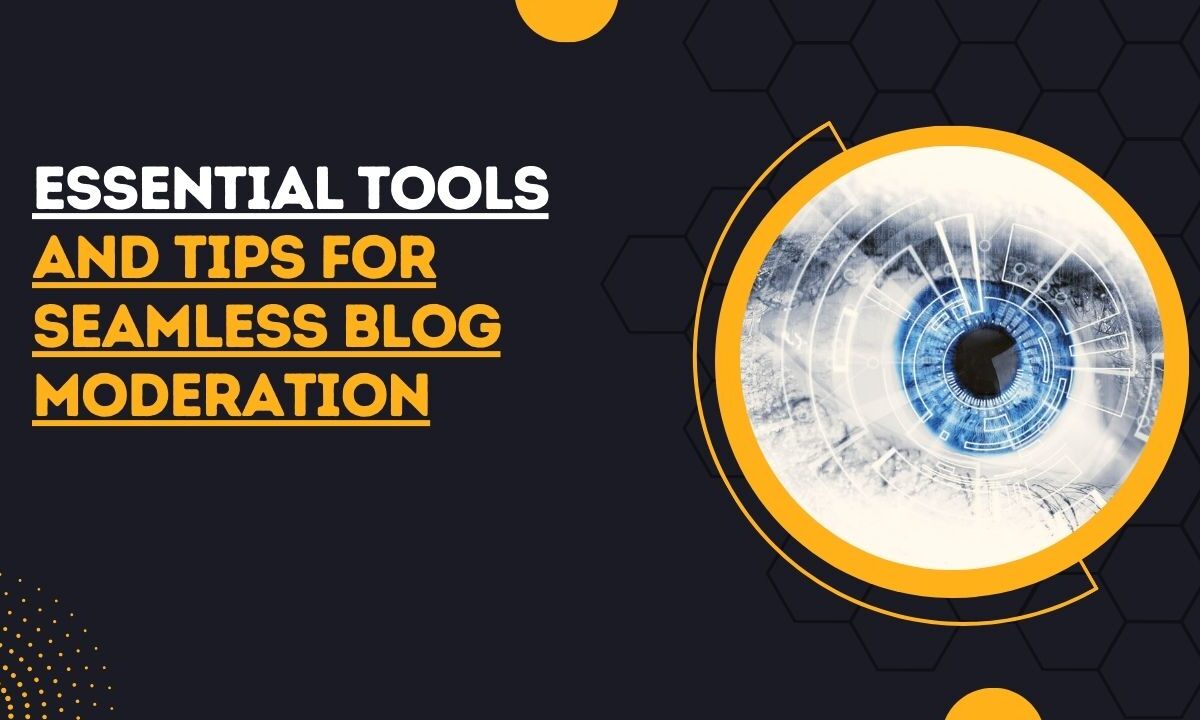Essential Tools and Tips for Seamless Blog Moderation
Are you struggling to keep your blog free of spam and manage comments efficiently? Tools for seamless blog moderation are more essential than ever to ensure your blog remains a productive, engaging space for your readers.
As your blog grows, so do the challenges of maintaining quality interactions and protecting your community from unwanted content.
In this article, we’ll dive into the best tools and tips for blog moderation, helping you streamline your process and focus on what really matters—creating great content.
Whether you’re a seasoned blogger or just starting out, tools for seamless blog moderation are crucisl to your success. Hence these strategies will save you time, reduce stress, and enhance your readers’ experience.
Ready to take control of your blog’s environment?
Keep reading to discover actionable insights that will transform your moderation process.
Why Blog Moderation Matters
Imagine walking into a room filled with chaos—shouting, spamming, and offensive remarks flying in every direction.
Would you stay?
Probably not.
Blogs are similar; readers won’t stick around if the environment isn’t conducive to meaningful conversations.
Blog moderation ensures that your platform remains:
- Respectful
- Spam-free
- Engaging
Moderation is not about silencing voices; it’s about amplifying the right ones. It’s the art of creating balance. This is where tools for seamless blog moderation come in handy.
Tools for Seamless Blog Moderation
1. Built-in Comment Filters
Most blogging platforms come equipped with basic comment filtering systems.
These filters work behind the scenes, scanning for keywords, spam patterns, or inappropriate content.

For instance:
- WordPress: Allows you to blacklist specific words or IPs.
- Blogger: Offers simple moderation settings to hold comments for review.
While these tools are basic, they lay a strong foundation. They’re like the bouncer at your party, handling the obvious troublemakers before they get through the door.
2. Third-party Moderation Plugins
When your blog outgrows the basics, it’s time to level up.
Third-party plugins provide advanced features to filter, manage, and analyze comments effectively. Popular options include:
| Plugin | Key Feature | Best For |
|---|---|---|
| Akismet | Spam detection | General-purpose blogs |
| Disqus | Community engagement tools | Blogs with active discussions |
| Commento | Privacy-focused moderation | Privacy-conscious platforms |
| Thrive Comments | Gamification for engagement | Interactive, user-driven blogs |
| CleanTalk | Anti-spam tools | Spam-heavy blogs |
These plugins often integrate AI and machine learning to spot patterns of spam or trolling behavior.
Think of them as the VIP security team ensuring only genuine contributors get in.
3. AI-Tools for Seamless Blog Moderation
Artificial intelligence has transformed moderation. With AI tools, you can:
- Automatically detect abusive language.
- Analyze sentiment in comments.
- Flag problematic patterns in real-time.
For instance, tools like Tidio and Moderator AI use advanced algorithms to keep discussions healthy and on-topic.
It’s like having a super-smart assistant who never sleeps, always ensuring your space remains inviting.
4. Social Listening Platforms
Ever wondered what people are saying about your blog elsewhere?
Social listening tools like Hootsuite and Brand24 track mentions of your blog across the web.
This information is invaluable. It lets you:
- Engage with your audience on multiple platforms.
- Address concerns or criticisms before they escalate.
Social listening tools help you create a 360-degree view of your community.
5. Custom Moderation Guidelines
Tools are helpful, but they’re only as good as the rules they follow.
Establishing clear, custom moderation guidelines ensures consistency.
Your rules should cover:
- Language: What’s acceptable?
- Spam: How is it defined?
- Respect: What behavior is expected?
Post these guidelines publicly, so commenters know the boundaries.
Transparency fosters trust.
6.Two-Factor Authentication (2FA) for Moderator Accounts
Secure your blog’s moderation process with 2FA for all moderator accounts.
This extra layer of security ensures only authorized individuals can access moderation controls, protecting your blog from unauthorized access.
It’s a simple yet powerful way to safeguard your platform from breaches and malicious activities.
7.Real-time Content Flagging Systems
Implement tools that allow readers to flag inappropriate or spammy content in real-time.
This empowers your audience to actively participate in maintaining a healthy community.
Moderators can then review flagged content promptly, reducing the chances of harmful comments slipping through and ensuring the integrity of discussions.
8.Analytics and Reporting Tools
Use analytics tools to track comment trends and recurring issues, providing valuable insights into your audience’s behavior.
These tools help you evaluate the effectiveness of moderation strategies, identify high-risk areas, and make data-driven decisions to improve the quality of interactions on your blog.
9.Scheduled Moderation Workflows
Set up automated workflows or moderation schedules to handle tasks at designated times.
This ensures consistent oversight without overwhelming your team, particularly during peak activity periods.
Scheduled moderation helps balance efficiency and accuracy, keeping your blog’s environment welcoming and free from harmful content.
Tips for Effective Blog Moderation
1. Be Proactive
Don’t wait for issues to arise.
Regularly monitor comments and address concerns quickly.
Readers value responsiveness, and a prompt reply can diffuse tensions instantly.
2. Encourage Positive Behavior

Reward meaningful contributions. Highlight insightful comments or feature regular contributors.
This motivates others to follow suit.
3. Use Clear Warnings
If a commenter crosses the line, a polite but firm warning often works wonders.
It’s a gentle reminder to stay within the rules.
4. Automate Where Possible
Manual moderation can be time-consuming.
Use automation for repetitive tasks like spam filtering.
This frees up time for meaningful interactions.
5. Engage Your Audience
Encourage readers to report problematic comments. They’re your eyes and ears, often spotting issues before you do. It creates a shared sense of responsibility.
6. Maintain a Neutral Tone
Avoid engaging in heated arguments. Neutrality signals professionalism and helps de-escalate conflicts.
Remember, you’re the host, not the referee.
7. Regularly Review Your Tools
Technology evolves. Periodically assess whether your current tools are meeting your needs.
Don’t hesitate to switch if a better solution becomes available.
8. Foster a Community-Driven Approach
Empower Readers with Reporting Tools
Implement a simple and visible way for users to report inappropriate comments or content. This tool should be easy to use and accessible on all devices, enabling your audience to flag issues instantly.
Reward Positive Contributions
Acknowledge top commenters or users who consistently engage in constructive discussions.
You can feature them on a leaderboard or offer rewards like exclusive access to content or discounts.
Create a Community Code of Conduct
Develop a document that outlines expected behaviors for your readers.
This could include guidelines on respectful language, personal attacks, and the type of content that’s appropriate to post.
Make the code easily accessible, and encourage your audience to adhere to it.
Host Community Moderation Days
Organize special events where users are invited to help with moderation.
For example, you could have a day where readers volunteer to review flagged content, which can help foster a greater sense of ownership and accountability in the community.
Provide Feedback to Your Community
After users report content or participate in moderation efforts, offer feedback on the results.
For example, if a flagged comment is removed, let users know why it was deemed inappropriate.
This reinforces the transparency of the process and builds trust in your moderation system.
9. Monitor Trends for Seamless Blog Moderation
Track Emerging Trends in Behavior
Pay attention to new patterns in trolling, spam, or off-topic discussions, and be ready to tweak your strategies to stay ahead.
Leverage Analytics for Insights
Use tools to analyze comment trends, identifying issues like peak activity times or frequently flagged topics for better preparation.
Adapt Moderation Policies Proactively
Stay flexible and revise your rules as needed to address changing audience dynamics or external factors like new technologies.
Staying vigilant ensures your blog remains a safe and engaging platform.
Regularly monitoring trends enables you to respond effectively to potential threats before they escalate.
10. Tips for Seamless Blog Moderation: Update Policies Regularly
Conduct Periodic Policy Reviews
Set a schedule for reviewing your moderation guidelines, ensuring they reflect current goals and best practices.
Seek Feedback from Moderators
Regularly check in with your moderation team for insights on the effectiveness of policies and areas needing improvement.
Engage with Your Audience

Poll readers about their experiences to gauge whether moderation policies are fostering the desired environment.
11. Collaborate with Others for Seamless Blog Moderation
Learn from Other Moderation Systems
Monitor how popular bloggers or forum owners manage their moderation systems.
Study their approaches to detecting spam, managing troll behavior, and fostering positive interaction.
By learning from others’ successes and failures, you can tailor your strategies to your audience.
Join Blogger Communities
Engage in online groups or blog communities where bloggers share their experiences with blog moderation.
Platforms like Facebook Groups or Reddit can provide valuable insights into which tools for seamless blog moderation work best.
These interactions can offer tips for avoiding common pitfalls.
Share Moderation Resources
Collaborating with fellow bloggers to create shared resources—like a best practices guide or a collection of useful moderation tools—can save time and effort.
Having a repository of information allows everyone involved to benefit from collective knowledge.
Participate in Cross-Promotions
Team up with other bloggers to promote each other’s content while also sharing best practices.
A strong network of bloggers can help with moderation efforts by offering advice or sharing resources, which ultimately strengthens the health of all blogs involved.
Co-host Moderation Webinars or Workshops
Partner with other bloggers to offer webinars or workshops on best practices for moderation.
By collaborating on educational initiatives, you can help your community grow and ensure that all participants are well-informed about moderation practices and tools.
FAQs
1. How can I reduce spam on my blog?
Use tools like Akismet or CleanTalk for effective spam detection. Customize filters to block frequent spam phrases.
2. Are AI tools better than manual moderation for blogs?
AI blog moderation tools are great for efficiency, but manual moderation adds a personal touch. A balance of both works best.
3. What should I include in my moderation guidelines?
Focus on language, respect, spam policies, and consequences for rule violations. Be clear and concise.
4. Can I disable comments altogether?
Yes, but it’s not always recommended. Comments foster engagement. Use strict moderation instead of removing them.
5. How often should I review comments?
Daily monitoring is ideal. For high-traffic blogs, consider reviewing comments multiple times a day.
6. Is third-party software necessary for new bloggers?
Not initially. Built-in tools work well for small blogs. Upgrade as your audience grows.
7. How do I handle offensive comments and trolls?
Trolls need immediate comment moderation. Hence, you need to remove offensive comments promptly. If needed, ban repeat offenders to maintain a positive environment.
Related Posts
Master Blog Moderation with Comment Filters Today
Use comment filters to automatically block spam and irrelevant content, ensuring a cleaner, more engaging blog experience.
Automating Blog Moderation with AI: Keep Trolls Out
AI moderation tools help automatically detect and remove offensive content, keeping your blog free from trolls.
Blog Commenting For Better SEO: A Surefire Path to Top Search Rankings
Effective blog commenting boosts SEO by fostering relevant discussions that drive traffic and improve search rankings.
Conclusion
When it comes to managing a thriving blog, tools for seamless blog moderation are an absolute necessity to maintain a positive and engaging space for your audience.
Effective moderation not only ensures the quality of content but also helps protect your community from spam, offensive behavior, and disruptions.
In this article, we’ll explore a variety of essential tools and tips to streamline your moderation process, making it more efficient and less time-consuming.
From AI-powered filters to community-driven approaches, you’ll discover how to create a welcoming environment for your readers without overwhelming yourself.
With the right tools for seamless blog moderation, you’ll be equipped to foster healthy conversations, reduce friction, and keep your blog on track for growth and success.

